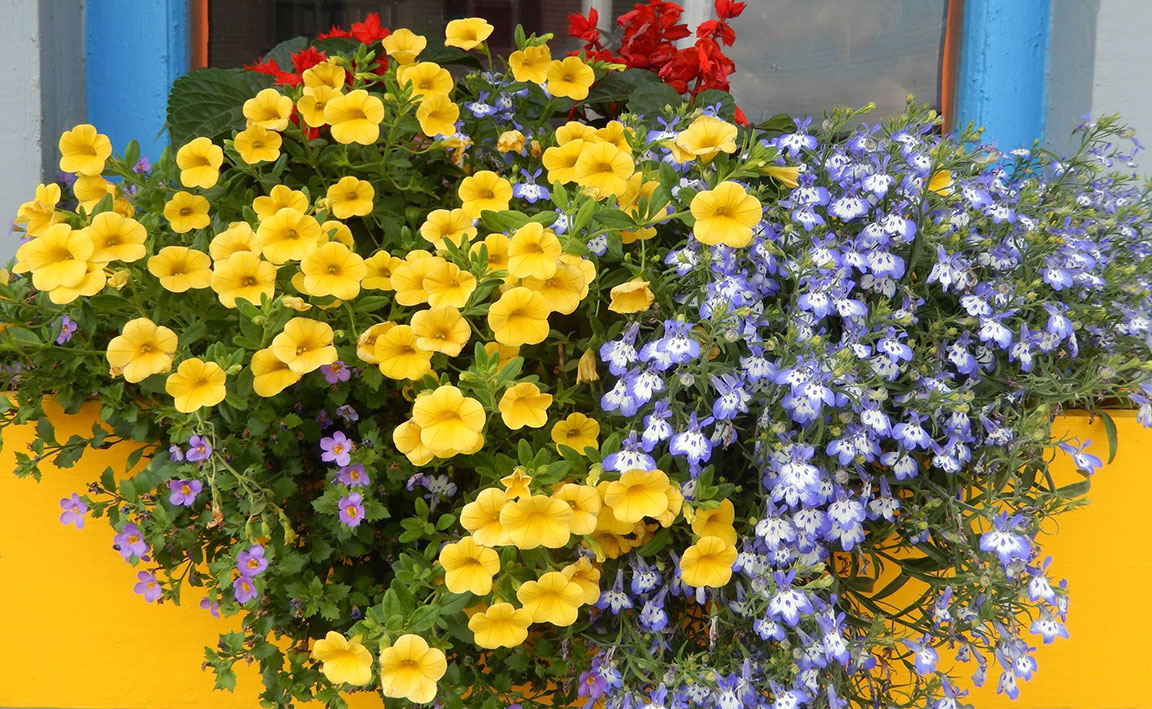
Maine Home Garden News — July 2018
- July Is the Month to . . .
- Weed Control Methods
- Plant Profile: Viburnum lentago (nannyberry)
- The Gardens at UMaine’s 4-H Camp & Learning Center at Blueberry Cove
- Food & Nutrition: Starting a Value-Added Food Business
July Is the Month to . . .
By Kate Garland, Horticultural Professional, UMaine Extension Penobscot County
- Find great gardening deals at yard sales. Keep an eye out for opportunities to “upcycle” miscellaneous items into artful container gardens and plant supports. I’m on a mission to find a used battery-operated hand vacuum to suck up garden pests that are too small and/or too fast to hand pick . . . watch out cucumber beetles!
- Support your local tomato. There are many benefits to keeping tomatoes up off the ground: improved airflow for disease management, better access to plants for inspection/harvest, and reduced potential for rodent damage. Watch these handy videos to learn how to stake, basket weave, trellis, and prune tomatoes.
- Keep planting trees, shrubs, perennials, and annuals. It’s perfectly fine to install herbaceous and woody plants in mid summer. The key to success is minimizing transplant shock and keeping a close eye on watering for the remainder of the season — sometimes monitoring for a few seasons with larger transplants. Try to plant on cooler, overcast days to reduce the evaporative demand that can lead to plant stress. For the remainder of the season, be sure to give newly installed plants about 1” of water a week over the course of 1-2 deep watering sessions instead of shallow watering events daily. One way to help get water directly to the root zone is to create a mini “well” for the water using a sunken plant pot or water bottle with small holes in the bottom. Filling the “well” instead of watering the soil helps the water seep directly into the soil instead of simply running over the top of the soil and away from the plants.
- Keep planting veggies. There’s still time for beets, carrots, beans, cucumbers, and a wide array of greens. Know your estimated fall frost date, days to harvest for the crop, and cold tolerance to determine the last planting date. Learn more in our article “Planting for Fall — How Late Can You Plant?”
- Prepare to preserve. Don’t find yourself short on supplies or food safety knowledge when the bounty arrives. Check out our series of food preservation videos, sign up for a workshop, and tap into a variety publications available for free online.
- Work smarter. Consider looking into adaptive tools to help you become more efficient in the garden. A simple switch to a lightweight hose, movable seat, or ergonomic hand tool can be a real game changer.
- Hug a farmer. Okay, maybe that’s a little beyond your comfort level (and theirs, too). At least give them a smile and your support at the market or farm stand. They’re working hard to not only feed us, but our neighbors in need. Did you know that farmers’ markets in the greater Bangor region have donated over 57,496 lbs of produce to local food cupboards and shelters since 2011? They’re part of an even larger network of farmers who welcome gleaners onto their farms and into their markets to make sure the food they are growing gets to as many plates as possible. Visit the Maine Gleaning Network (a partner of UMaine Cooperative Extension’s Maine Harvest for Hunger) to learn more.
Weed Control Methods
By Donna Coffin, Extension Professor, UMaine Extension Piscataquis County
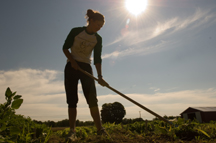
There are a number of ways to control weeds in our gardens including physical destruction, competition, mulching, biological control, and herbicides. Let’s look at how these methods are used home gardens.
Most gardeners are familiar with plowing, cultivating, hand pulling, mowing, rototilling, and chopping of weeds to get them under control in a garden. Some folks try burning (weed seedlings must be very small), heat sterilization (solarization) during the hot part of summer or microwaving small quantities of soil (a very smelly option.) Deep tillage can bring up many weed seeds that have been lying dormant in the soil; so after the initial tillage is done, only shallow cultivation (less than one inch deep) should be continued throughout the season. Annuals less than two inches in height are most susceptible to shallow tilling. Check out this great overview on physical control methods from UMaine weed researchers.
More aggressively growing desirable plants can better compete with less desirable weeds for water, nutrients and light. Soil testing, followed by amending the soil according to the recommendations on the report is an important step in helping those desirable plants become more competitive. Also, more intensive plantings (closer spacing), rotation, and cover crops can reduce weed pressure. Providing the best environment for your desirable plants will help them thrive. For example, grass needs full sun, high levels of soil nutrients, and plenty of moisture to thrive and out compete lawn weeds. Trying to grow grass in a shady, nutrient poor or dry area will lead to weeds.
Mulching with plastic, organic or recycled materials can help prevent weed seeds from germinating during the summer. When using organic mulches (straw, wood shavings, wood chips, etc.), a minimum of 3 inches of mulch is typically most effective. Beware: “mulch hay” will bring in a lot of seeds to your garden! Mixing in some compost with bark mulch allows it to break down a bit faster and not accumulate as quickly. This strategy was inspired by Coastal Maine Botanical Gardens, where they use a blend of bark and compost on many of their perennial gardens.
Wouldn’t it be nice to release some type of ravenous insect that would eat all the undesirable weeds and leave our desirable crop alone? Scientists have been able to find a limited number of very specific biological controls (bugs, fungi, bacteria, etc.) for very specific weeds species. Here’s a very comprehensive guide (PDF) that offers some interesting updates on this growing area of research.
The last method of weed control is with herbicides — any chemical (organic or inorganic) used to kill or inhibit the growth of a plant. You’ll need to consider the growth stage of the weed, type of weed, and types of surrounding plants (if any) when selecting an herbicide.
A pre-plant or pre-emergent herbicide is applied to the soil for control of weeds before or as they are germinating. Trifluranlin or corn gluten meal can be used to suppress weed seed germination in home gardens after the desirable plants are up and growing or after transplants are planted. Post-emergent herbicides, such as those with the active ingredient 2,4 D, are commonly used on lawns to control broadleaf weeds. Many of our vegetable crops and ornamentals are broadleaf plants, so it is important not to use 2,4 D or the grass clippings that have been sprayed with 2,4 D as a mulch or organic soil amendment.
In areas that have not been planted yet, or as a directed spray after planting, a non-specific herbicide can be used. Non-specific herbicides include glyphosate or 25% vinegar/acetic acid. Use with extreme care to avoid spray contact with foliage of plants.
Herbicides listed here are common and often easy for consumers to find; there are many other acceptable herbicides on the market that may suit a similar purpose. Always consult the label before applying any pesticide on a specific crop or crop cultivar.
Most importantly, it’s essential to identify the weed(s) to determine the most effective management method. Refer to the article Understand Weeds to Understand Weed Control and this online weed ID tool from Cornell University, and/or reach out to your local UMaine Cooperative Extension office for help with plant ID and management advice.
References/Resources
- Uva, R., J. Neal, J. DiTomaso, Weeds of the Northeast 1997
- Erhardt, W., Weeds and Weed Control; Commercial Vegetable News, Special Newsletter No. 9, April 1992.
- Rate Hand Cultivation Tools — UMaine Weed Ecology and Management website
Reich, L., Weedless Gardening, 2001 - UMaine Extension Master Gardener Manual Section on Pest Management
Plant Profile: Viburnum lentago (nannyberry)
By Kate Garland, Horticultural Professional, UMaine Extension Penobscot County
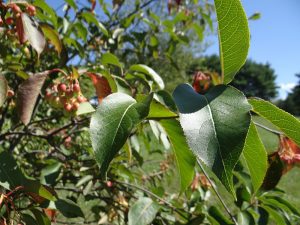
One of the many reasons why I enjoy fly fishing is that I get the opportunity to closely observe plants growing in the riparian zone (i.e. land that occurs along bodies of water). These plants offer a fun challenge for those of us who love identifying plants and reading nature. One plant, in particular, is pretty easy to spot in early to mid July — Viburnum lentago (nannyberry). I happen to be lucky to also enjoy seeing it from my office window, as it’s planted in the Eastern Maine Native Plant Arboretum that surrounds the UMaine Extension Penobscot County office at 307 Maine Avenue in Bangor.
Nannyberry is a sturdy, vase-shaped shrub with deep green, slightly glossy foliage and bright white, fat-topped inflorescences that appear in early July. The flowers turn from green to orange and eventually develop into deep, purplish-blue fruit that are enjoyed by birds and other wildlife. Plants prefer full sun, reaching a height of 15-25’ and typically spread about 3/4 as wide. The trio of nannyberry planted in full sun and heavy soils behind our office are approximately 8-12’ and don’t seem to be getting much taller. Nannyberry can also be easily trained into a tree form, as pictured in the UMaine Cooperative Extension bulletin featuring nannyberry. Interestingly, this plant is well adapted to both moist and dry soil conditions.

Our three shrubs put on a lovely autumn show with leaves shifting from red to purple, paired with the colorful fruits held on bright red stems. Sadly, they’re not located in a spot that folks would normally see when dropping off plant samples or coming by for a meeting, but I’m always happy to point them out to any visitors stopping by.
Established in 2004, the Eastern Maine Native Plant Arboretum is an outdoor classroom for the study of native tree and shrub species best suited for managed landscapes in the Northeast. This unique collection of native woody plants are still young and we are watching them carefully as they adapt to living in this challenging urban environment. In 2013, a parking lot was installed in the middle of the arboretum. During construction, a number of trees needed to be transplanted in the middle of the growing season. It has been very interesting to see which ones have survived and how they seem to be recuperating from the various stresses (both large and small) they’ve encountered over the years.
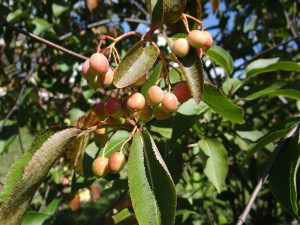
While enjoying the arboretum, you can look for species that might be suitable for your home, work, or school grounds. You can help preserve Maine’s unique diversity of plant and animal life by landscaping with native plants. We encourage visitors to stop into our office if you have any questions during your visit.
Additional information:
The Gardens at University of Maine 4-H Camp & Learning Center at Blueberry Cove
By Jane Bracy, Master Gardener Volunteer
Blueberry Cove Camp was a half mile down the road from my grandparent’s summer cottage in Tenants Harbor. I didn’t get to go there as a camper, but the Haskells, who owned and ran the camp, would invite me to join the other children for special gatherings and singing around the fire. So my love for the camp has a long history.
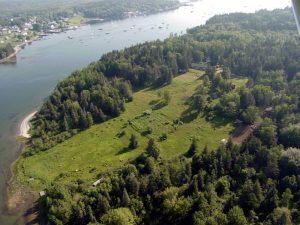
When the 25-acre property came up for sale in 2005, a committee was formed to raise funds and save it from development. After working with that group, I went on to join the board of Blueberry Cove and Tanglewood 4-H Camps, now part of the University of Maine Cooperative Extension.
The original camp had a one-acre vegetable garden overlooking the harbor. I began tackling the overgrown area in 2006, and took the Master Gardener Volunteer training in 2009 to hone my skills. Since then, the garden has grown with new volunteers, new ideas, and new campers each session.
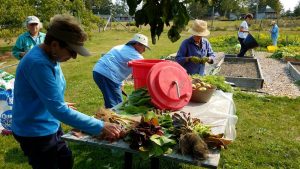
It’s a big garden to care for, but with dedicated volunteers and a supportive camp director, it has become very productive and a great place for people of all ages to learn. Some volunteers prefer to tend the cut flower border, others like to work on vegetables. Our most organized person keeps track of rotation and succession planting on a spreadsheet. Much of the food is grown in raised beds, including one with herbs by the cook’s door. We also have a small orchard with apple and peach trees, highbush blueberries, of course, and for later in the season, giant and small pumpkins for local schools. The fresh food feeds many hungry campers and contributes to a half-marathon fall fundraiser. In 2017, we raised all of the lettuce and cucumbers used in the camp kitchen.
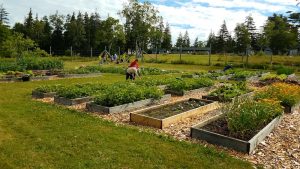
The work comes with many rewards: joy in hearing excited children running down the hill to explore the garden; watching them pull carrots, pluck peas, and dig potatoes for the first time; helping them catch bugs, find snakes, and chase voles; seeing their looks of amazement at a vegetable just harvested (hopefully washed) and eating it right there. Not to mention the beautiful view.
Blueberry Cove Camp welcomes visitors and volunteers. The garden group works on Tuesday mornings, so come down to the St. George peninsula and see what we’re doing.
Food & Nutrition: Starting a Value-Added Food Business

Based on Bulletin #3101, Recipe to Market: How to Start a Specialty Food Business in Maine prepared by Extension Food Science Specialist and Associate Professor Beth Calder and Professor Emeritus Alfred Bushway.
Adapted for Maine Home Garden News by Robson Machado, Ph.D., Assistant Extension Professor and Food Science Specialist.
Specialty food producers, often operating home-based microenterprises, are a growing Maine industry. Starting a Maine home-based food business involves facing challenges such as licensing, food safety, and building business skills. Also, some recipes and food products for sale may need to be sent to UMaine for testing. Here are some answers to frequently asked questions we hear from people interested in starting a small food business in Maine.
1. Is starting a food business right for me?
It is okay to decide against owning a food business. Starting a food business is a considerable commitment of time, capital, and energy. Also, not all food products can be easily converted to retail items. However, if you choose to proceed, having the right personality and a solid business plan will help you to be successful!
2. How do I start, and where do I turn as I begin the process of starting my own food business?
When cooking for family and friends, most cooks have their recipes memorized, or they use a pinch of this or that. When developing a food product for customers, you must develop standardized recipes with exact measurements, preferably based on weight, temperatures, and times, etc., to ensure batch-to-batch consistency.
3. What sort of license do I need to sell my food product?
A state food license is required for everyone who sells a food product in Maine. The two common licenses are a home food processor or a commercial food processor license. If you are interested in selling at a farmer’s market, a mobile food vendor license will be required as well.
4. Where do I get my food license? What are the food laws and rules for my product?
The Maine Department of Agriculture, Conservation, and Forestry Division of Quality Assurance and Regulations issues food licenses/permits, provides food inspections before and after you start your food business, and provides information about state food regulations. Inspectors are also available to conduct pre-inspections to look at your kitchen or space and to discuss ideas before you renovate. For more information on their inspection programs, visit Maine Department of Agriculture, Conservation, and Forestry: Inspections.
5. Can I produce my food product at home?
Depending on the type of product that you want to sell, you may be able to obtain a home food processor license and produce non-perishable food products (foods that do not require refrigeration or freezing) and are considered shelf-stable foods in your home kitchen. Jams, jellies, pickles, relishes, sauces, marinades, most candies/confections, and baked goods (unless the finished baked goods have butter/cream cheese frostings or custard fillings) are examples of products that can be safely processed in your home kitchen.
6. What makes a food “potentially hazardous”?
This term may seem strange, but this is how we refer to food products that are dependent on refrigeration or freezing to reduce microbial growth. Food is categorized as potentially hazardous based mainly on its pH and its water activity value (aw). A perfect example is pesto. Fresh pesto has a pH above 4.6, has an aw of greater than 0.85, and requires refrigeration to minimize microbial growth. If you were interested in producing fresh pesto, you would have to produce it in a commercial facility, not in the home kitchen.
7. When do I need to send in my food product for testing at UMaine?
If you are a Maine food processor, most baked goods (that do not contain dairy-based frostings/fillings), plain berry-based jams/jellies (raspberry, blueberry, and strawberry jams/jellies), candies/confections, and dry spices/rubs/mixes do not need to be sent to UMaine for food testing. However, jams and jellies that have combinations of fruit, or do not contain fruit (wine, spice or pepper jellies) must be tested. If you have questions if your food product requires testing at UMaine before it is sold, please contact us.
The Process and Product Review Testing is conducted at the School of Food and Agriculture at the University of Maine. Dr. Beth Calder, Dr. Jason Bolton, and Kathy Davis-Dentici provide a team approach to conduct food testing on a part-time basis and write review letters to determine whether your food product falls under the appropriate food safety guidelines and/or standards of identity.
8. What do I need to have on my food label?
All food producers must list the following items on their food labels:
- the statement of identity (name of food product),
- net weight of food product (usually measured in both ounces and grams or by count),
- ingredient listing (listed in descending order by weight of ingredients),
- potential allergens in a food product*, and
- name and address of the manufacturer, packer, or distributor.
Refer to the FDA’s A Food Labeling Guide online or request a copy from the FDA at 240.402.2373.
*The eight food allergens that require an allergen statement are milk, eggs, fish, wheat, crustacean shellfish (such as lobster and crab), tree nuts, peanuts, soybeans, and also includes sulfites.
9. Where can I get help with improving my business skills, writing a business plan, and marketing my food product?
University of Maine Cooperative Extension offers small-business education in selected counties. Contact your UMaine Cooperative Extension county office or call 800.287.0274 (in Maine) to find your local office. You can also browse UMaine Extension’s Small Business Library and UMaine Extension’s Resources for Small Food Businesses in Maine including Recipe to Market Workshops on how to start a food business in Maine.
University of Maine Cooperative Extension’s Maine Home Garden News is designed to equip home gardeners with practical, timely information.
Let us know if you would like to be notified when new issues are posted. To receive e-mail notifications fill out our online form.
For more information or questions, contact Kate Garland at katherine.garland@maine.edu or 1.800.287.1485 (in Maine).
Visit our Archives to see past issues.
Maine Home Garden News was created in response to a continued increase in requests for information on gardening and includes timely and seasonal tips, as well as research-based articles on all aspects of gardening. Articles are written by UMaine Extension specialists, educators, and horticulture professionals, as well as Master Gardener Volunteers from around Maine, with Katherine Garland, UMaine Extension Horticulturalist in Penobscot County, serving as editor.
Information in this publication is provided purely for educational purposes. No responsibility is assumed for any problems associated with the use of products or services mentioned. No endorsement of products or companies is intended, nor is criticism of unnamed products or companies implied.
© 2018
Call 800.287.0274 (in Maine), or 207.581.3188, for information on publications and program offerings from University of Maine Cooperative Extension, or visit extension.umaine.edu.

